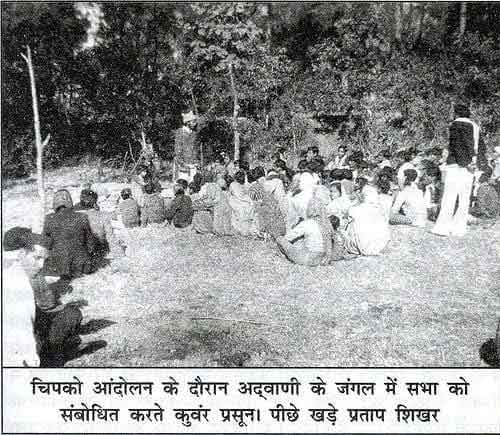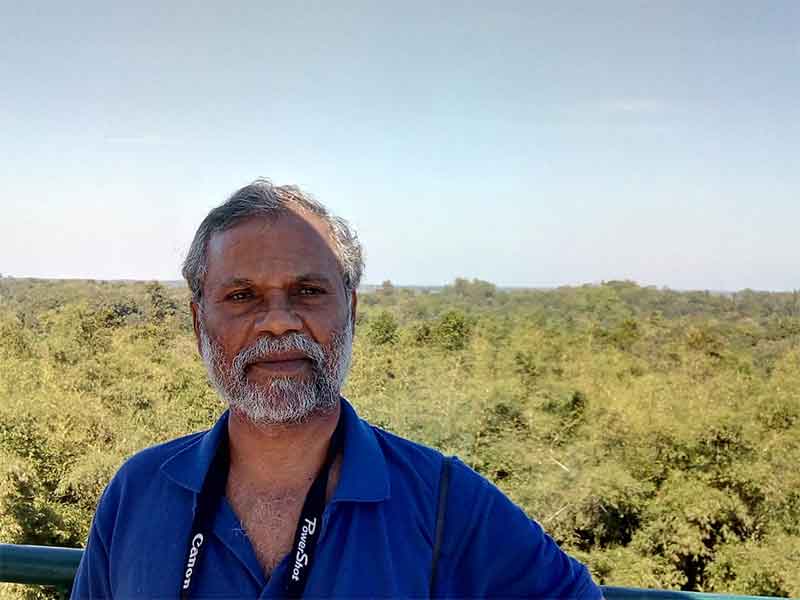
The first stories of Chipko ( hug the trees to save them from felling) movement came from Chamoli district in Garhwal region where Gaura Devi and other hill women chased away workers who had come to fell trees. However by the late 1970s when as a young reporter I started writing on this movement, consciousness regarding this movement had spread to a much wider part of both Garhwal and Kumaon regions of Uttarakhand.
In fact my own first visit in this context was to Kumaon region where I met several activists of Nainital and Almora who in later years played an important role in social and ecological movements, grassroots journalism and academics. However the place which I could visit repeatedly was the Henvalghati region of Garhwal, which soon became a main hub of the chipko movement.
The most senior Gandhian activists in Garhwal at that time were Sundelal Bahuguna and Vimla Bahuguna. In Henvalghati they had several younger upcoming colleagues like Kunwar Prasun, Vijay Jardhari, Sahib Singh and Pratap Shikhar, as well as their teacher from school days Dhum Singh Negi, who played a brave role in mobilizing people for saving trees which were being auctioned for felling. In fact some protests started right at the auction site and villagers, including women who occupied the auction site, were imprisoned.
Women played a leading role and some like Sudesha Devi emerged as leading activists. Apart from protesting against direct felling villagers also came out to protest against the excessive extraction of resin from pine trees which led to their heavy falls even in mild storms.
I remember vividly the inspiring events in Advani forest of Henvalghati region where the authorities sent a big police force to help the contractor in cutting trees. But women and other villagers would rush to hug trees and it was just not possible to cut trees without hurting women. Finally the tree felling efforts were called off. Police, contractor and workers went back.
In Salet forest Dhum Single single handedly saved forest by running from one tree to another to hug them before other villagers could reach. In Badiyargad Sundelal Bahuguna had to fast for several days to stop more tree felling. All these efforts led to sporadic saving of trees at several places but the bigger victory came when finally the demand for a moratorium on green felling of trees over a vast area was accepted in Uttarakhand region (then a part of Uttar Pradesh).
Sunderlal and several activists embarked on a very risky Kashmir to Kohima foot march to take the message of the movement all over the Himalayan region. Other villagers took up several constructive activities to take forward the work of regenerating forests in degraded areas. Vijay Jardhari initiated a movement for saving traditional seeds.
Some years later a new threat emerged in Henvalghati as felling of a very large number of trees was in announced to install the transmission network for taking Tehri project electricity to plains. But villagers led by Kunwar Prasun again resisted and as a result of these efforts new surveys were carried out and a significant number of trees could be saved.
While visiting these areas time and again at that time I met a pleasant youth who was introduced to me by Sunderlal Bahuguna as a brilliant student from Delhi School of Social Work. Although he had come for his study internship but he was willing to take up a lot of work and responsibilities and was eager to learn a lot. I later learnt that this youth Pandurang Hegde passéd out as a gold medalist and was even offered a job in the PMO after Sunderlal Bahuguna had taken him along on a meeting with the then PM Mrs. Indira Gandhi to discuss problems of Himalayan region. However instead of rushing to take this job he had decided to return to his roots in rural Karnataka ( in Western Ghats region) and initiate similar campaign of saving forests. To help him, initially Sunderlal Bahuguna also visited the area where he was working and this visit proved to be very inspiring for villagers.
The Appiko Movement in Western Ghats was thus born with successful hug-the-trees initiatives in Kalase forest and Husri forest and other areas of Uttarakannada district, followed by acceptance of demand for moratorium on green felling over a much wider area. Here again there was later extension to several other constructive activities including those relating to minor forest produce and campaign to save honey bees.
However this success was threatened by the launching of many dam projects and other projects in both these regions which threatened several hundred thousand trees apart from causing other environmental and safety risks and displacing thousands of households. Hence activists of both movements later became involved deeply in more difficult campaigns of opposing these projects. These were more tense times.
Both chipko and appiko remain highly inspiring example of people’s actions to protect forests and reassert a more protective relationship with forests. In the course of reporting these movements for several years and taking their message to more people, I along with my family received the additional blessing of several very close and durable friendships.
Bharat Dogra is a journalist and author. His recent books include ‘Vimla and Sunderlal Bahuguna—Chipko Movement, Struggles Against Tehri Dam’ Project and ‘Pandurang’s Story’.
GET COUNTERCURRENTS DAILY NEWSLETTER STRAIGHT TO YOUR INBOX
















































